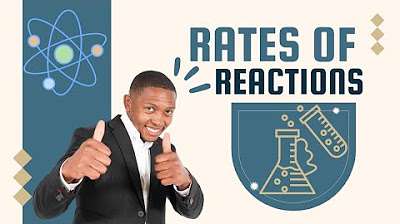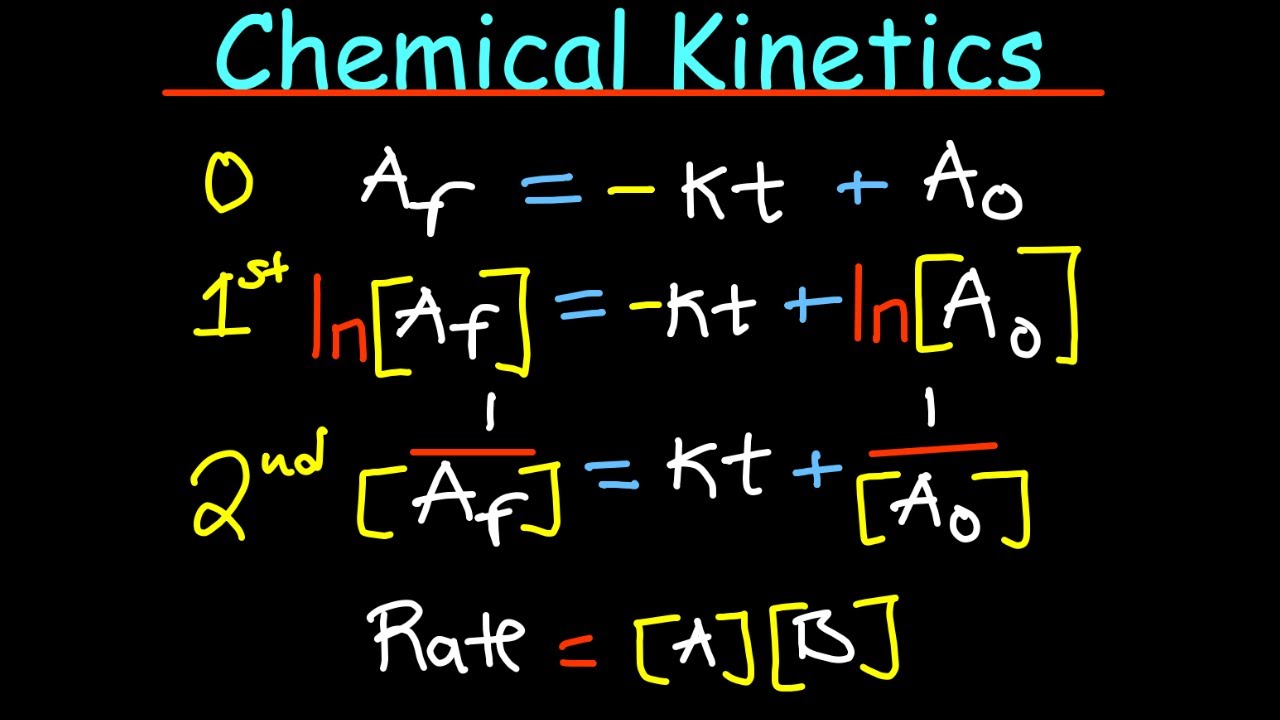Unit 5.1 - Reaction Rates
TLDRIn this educational video, the focus is on understanding reaction rates, a key concept in the study of kinetics. The video begins with a factoid about a Nobel Prize winner and delves into the distinction between kinetics and kinematics. It explains how reaction rates are measured by tracking changes in concentration over time, using the synthesis of ammonia as an illustrative example. The video also touches on factors affecting reaction rates, such as reactant concentration, temperature, surface area, and the presence of catalysts. The example of magnesium reacting with hydrochloric acid is used to demonstrate how surface area influences the rate of a chemical reaction.
Takeaways
- 📚 The lecture introduces Unit 5.1, focusing on reaction rates, a topic within the field of kinetics.
- 🏆 A factoid mentions a Nobel Prize winner for a cancer cure, but it's clarified that such a cure has not been discovered yet.
- 🧪 Kinetics is distinguished from kinematics and is defined as the study of reaction speeds, or how fast/slow chemical reactions occur.
- 📈 The speed of a reaction is measured by the change in concentration of reactants or products per unit of time.
- 📊 An example is provided using the synthesis of ammonia to illustrate how the concentration of reactants (hydrogen and nitrogen) decreases and the concentration of the product (ammonia) increases over time.
- 📈 The rate of a reaction can be represented graphically, with time on the X-axis and concentration on the Y-axis.
- 🔄 The script explains how the stoichiometric coefficients in a chemical equation affect the rates of disappearance of reactants and appearance of products.
- 📐 The units for reaction rates are molarity per second (mol/s or M/s), indicating concentration change over time.
- 🔧 Factors affecting reaction rates include reactant concentration, temperature, surface area, and the presence of catalysts.
- 🌡️ Increasing reactant concentration leads to more collisions between particles, thus increasing the reaction rate.
- 🌞 Raising the temperature increases particle movement and energy, resulting in more collisions and a faster reaction rate.
- 🏙️ The example of magnesium reacting with hydrochloric acid illustrates how surface area affects reaction rates, with ground magnesium reacting faster due to its greater surface area.
Q & A
What is the main topic of unit 5.1?
-The main topic of unit 5.1 is reaction rates, which focuses on how fast or slow a chemical reaction takes place.
What is the difference between kinetics and kinematics?
-Kinetics is related to reaction speeds in chemistry, while kinematics is a physics term that deals with the motion of objects without considering the forces that cause the motion.
How is the speed of a chemical reaction measured?
-The speed of a chemical reaction is measured by the change in concentration of a reactant or a product per unit of time, expressed in terms of molarity per second.
What does the graph of the synthesis of ammonia reaction show?
-The graph shows the concentration of hydrogen and nitrogen decreasing over time as they are consumed in the reaction, while the concentration of ammonia, the product, increases over time.
How do molar ratios affect the rates of reactant disappearance and product appearance?
-The rates of reactant disappearance and product appearance are directly related to the molar ratios indicated by the coefficients in the balanced chemical equation. For example, if nitrogen disappears at a rate of 0.025 molarity per second, hydrogen will disappear at a rate of 0.075 molarity per second (three times as fast), and ammonia will appear at a rate of 0.050 molarity per second (twice as fast as nitrogen disappears).
What are the units typically used to express the rate of a reaction?
-The units used to express the rate of a reaction are typically molarity per second (mol/L/s), which represents the change in concentration over time.
What factors can affect the speed of a chemical reaction?
-Factors that can affect the speed of a chemical reaction include reactant concentration, temperature, surface area, and the presence of catalysts.
How does increasing the concentration of a reactant affect the reaction rate?
-Increasing the concentration of a reactant leads to more collisions between reactant particles, which in turn increases the reaction rate.
What is the difference between average rate and instantaneous rate?
-The average rate is the change in concentration over a longer period of time, while the instantaneous rate is the rate at a specific moment, often found by determining the slope of the tangent to the curve on a graph.
Why does increasing the temperature of a reaction increase the reaction rate?
-Increasing the temperature causes the particles to move faster and have more energy, leading to more collisions and thus a faster reaction rate.
How does the surface area of a reactant affect the reaction rate?
-A larger surface area allows for more collisions between reactant particles, as more atoms or molecules are exposed to the other reactants, leading to an increased reaction rate.
In the example problem with magnesium and hydrochloric acid, which reaction is expected to proceed faster and why?
-The reaction with ground magnesium (figure two) is expected to proceed faster because it has a greater surface area, leading to more collisions between the magnesium particles and the hydrochloric acid.
Outlines
📚 Introduction to Reaction Rates
The video begins with an introduction to unit 5.1, focusing on reaction rates. The instructor starts with a factoid about a Nobel Prize winner, although it's noted that the cure for cancer has not been discovered yet. The main topic, kinetics, is clarified as the study of reaction speeds, distinct from kinematics in physics. The concept of measuring reaction speeds by the change in concentration of reactants or products per unit of time is introduced, with an example of the synthesis of ammonia. The video emphasizes that reaction rates depend on the stoichiometric coefficients of the reactants and products.
🔍 Calculating Rates and Molar Ratios
This paragraph delves into the calculation of reaction rates, emphasizing the importance of understanding molar ratios. The instructor uses a hypothetical scenario where the rate of nitrogen disappearance is given, and the task is to calculate the rate of disappearance for hydrogen and the rate of appearance for ammonia. The process involves using the stoichiometric coefficients to find the corresponding rates for other substances involved in the reaction. The paragraph also introduces the concepts of average rate and instantaneous rate, and hints at the connection between calculus and kinetics.
🌡️ Factors Affecting Reaction Rates
The final paragraph discusses various factors that can influence the speed of a chemical reaction. These factors include reactant concentration, temperature, surface area, and the presence of catalysts. The explanation is supplemented with an example problem involving magnesium reacting with hydrochloric acid, where the surface area of magnesium is varied to demonstrate its effect on reaction rate. The video concludes with a summary of the main points covered in the lesson and an anticipation of future topics.
Mindmap
Keywords
💡Reaction Rates
💡Kinetics
💡Molarity
💡Synthesis Reaction
💡Concentration
💡Stoichiometric Coefficients
💡Instantaneous Rate
💡Factors Affecting Reaction Rates
💡Catalysts
💡Surface Area
Highlights
Introduction to unit 5.1 focusing on reaction rates.
Misconception about Nobel Prize for finding the cure for cancer.
Explanation of kinetics as it relates to reaction speeds.
Differentiation between kinetics and kinematics.
Method of measuring reaction speed through change in concentration.
Example of synthesis of ammonia to illustrate reaction rates.
Relationship between reactant concentration and reaction speed.
Impact of reactant coefficients on the rate of consumption.
How product concentration changes over time in relation to reactants.
Calculation of rates using molar ratios.
Units of reaction rate measurement (molarity per second).
Difference between average rate and instantaneous rate.
Factors affecting reaction speed: reactant concentration, temperature, and surface area.
Use of catalysts to speed up reaction rates.
Practical example comparing reaction rates of magnesium with hydrochloric acid based on particle surface area.
Explanation of why ground magnesium reacts faster than solid block magnesium.
Conclusion of unit 5.1 and encouragement for future learning.
Transcripts
Browse More Related Video
5.0 / 5 (0 votes)
Thanks for rating:





